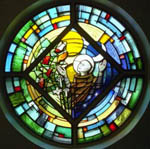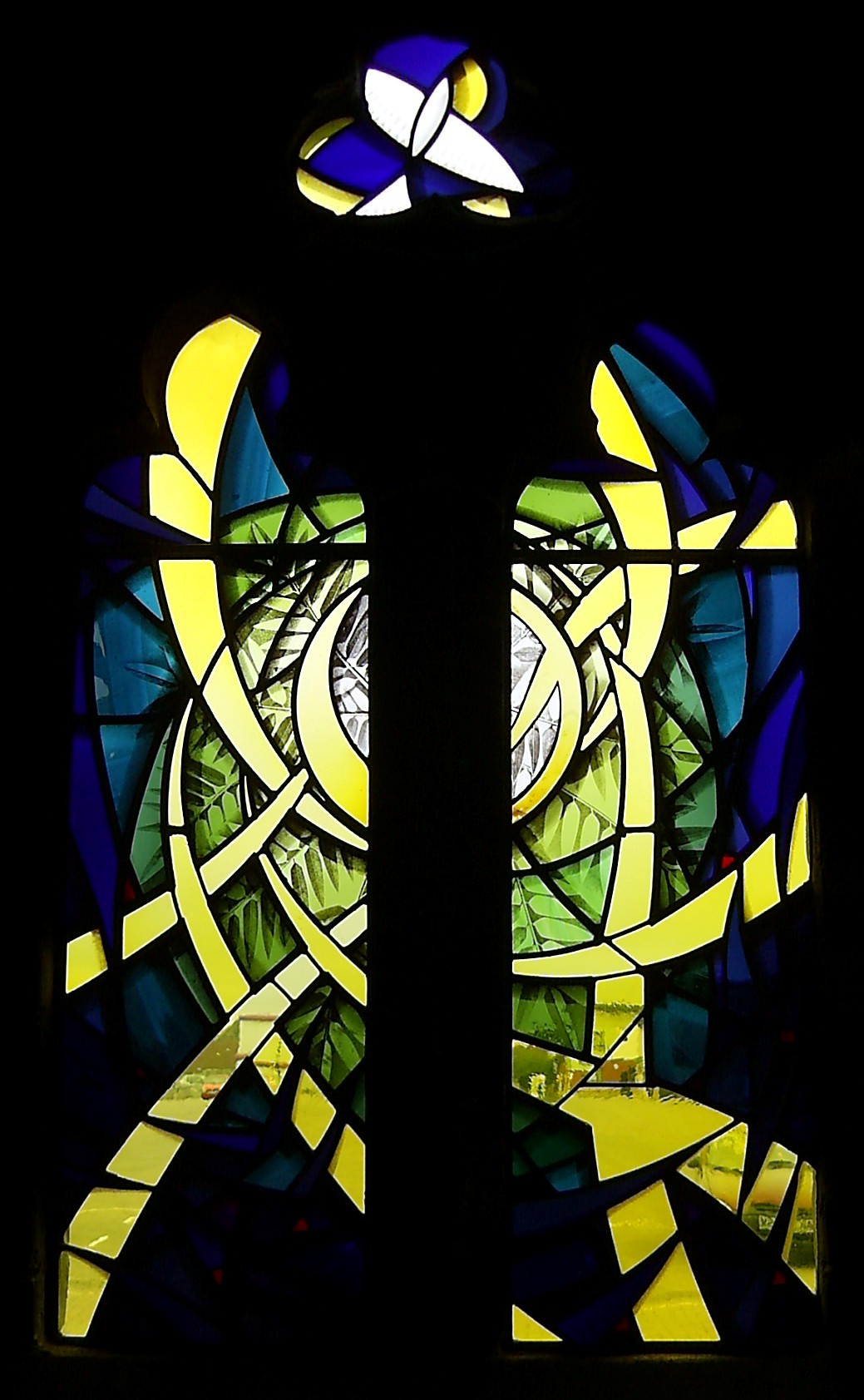The beauty of glass - work by Ann Sotheran FMGP
 Having designed and made stained glass for many different situations including private houses, churches, public houses, exhibitions and galleries, Ann Sotheran derives the most pleasure from working in close consultation with the client or donor in the initial stages of the design.
Having designed and made stained glass for many different situations including private houses, churches, public houses, exhibitions and galleries, Ann Sotheran derives the most pleasure from working in close consultation with the client or donor in the initial stages of the design.
She explains:
I like to explore, with them, their reasons for commissioning a piece of work in order that I can develop images which will most closely reflect their feelings and aspirations and evoke a positive response to the finished piece.
I enjoy playing with symbols and motifs which have secondary meanings as well, so that the work can he read on several different levels. In church windows this is easy as so many familiar images have secondary meanings – a fish represents Christ, a hovering dove represents the Holy Spirit, a rainbow represents God’s promise of His eternal love and care of mankind and so on. A similar approach can be taken towards secular work where a tree may be a simple reference to a local feature, or may stand for growth and development, or a solidly rooted and burgeoning community – concepts which would be comprehensible to anyone looking at the work, whatever their cultural background.
Having trained in the traditional methods of stained glass I still work mostly within that discipline. I like being able to hand build my work, selecting and cutting all the glass myself painting it, acid-etching and staining where necessary, and leading up, making decisions and having personal control at every stage. I like to incorporate unusual elements in terms of types of glass,often using “found”glass such as bottle bottoms in domestic and decorative work.Otherwise I use a range of hand-made antique glass, English for preference, mixing it with other types as necessary to get the desired effects.
Here I would like to share with you some of my favorite works.
 Project 1 – St Boniface’s church, Bunbury, Cheshire. 2005
Project 1 – St Boniface’s church, Bunbury, Cheshire. 2005
This five light window was commissioned for the east window of the Ridley chapel in St Boniface’ church, to commemorate the life of Canon Ridgway who was responsible for the restoration of the church following extensive damage in World war II. The theme of the window is Easter Day.
The central light depicts Christ rising in glory from the darkness of the tomb at His feet, the vesica shaped background is symbolic of rebirth and He is surrounded by the heavens. The flowers at the foot of the window are spring flowers, daffodils, lilies and hawthorn. The lilies refer to the annunciation and the thorns of the hawthorn make a subtle reference to the crucifixion.
Mary Magdalene is shown in the left-hand light, reaching out to touch Christ who is displaying His wounds. In the right-hand light is a hovering angel holding the vexillum – the banner of the Resurrection – which swirls around the central figure.
The whole window measures approximately 4, high and 2.5 m wide. It is made of etched, painted and stained antique glass, and retains the original ferramenta on the exterior.
 Project 2 – The Trinity centre North Ormesby, Middlesbrough 2007
Project 2 – The Trinity centre North Ormesby, Middlesbrough 2007
As part of the development of the Trinity Centre it was decided to convert an under used storage room into a quiet room for prayer, meditation and small group meetings for people of all faiths. The room opens onto an enclosed garden which had just been landscaped with a brick path maze and new planting.
The theme of the window is a journey through a dark and thorny environment to a bright centre full of growth and life. The journey continues upwards to a free flying bird. The design is deliberately non-denominational.
The window measures approximately 1m high, excluding the tracery, by 80cm wide, and is made of painted and stained antique glass

Project 3 – privately commissioned gift 2009
This tiny panel was commissioned as a Christmas present. It is approximately 28cm by 33cm and is installed in the study of an 18th C cottage near York. It is made of painted antique glass with added decorative detail.

Project 4 – Ingleby Barwick Community College, Cleveland 2004
This window was commissioned as the first of a projected series of four for the newly built All Saints’ C of E school at Ingleby Barwick. It was the only one completed and installed, although the designs still exist for the other three, also depicting saints. This window is situated in the refectory.
Here St Francis of Assisi is shown preaching to the birds, which perch in a tree listening to him. All around the figure are images taken from his teachings and writings, with texts variously etched and painted onto the glass giving some details of his life. The 1m70 diameter window is made in five sections which are set into a timber frame, and it is externally glazed with toughened glass. It is made of mixed antique and machine-made glass, with painted, stained and acid-etched detail.
 Project 5 – “Foster” panel (private commission) 2008
Project 5 – “Foster” panel (private commission) 2008
This 1m panel was commissioned for a private house near York, to be inserted into a circular opening in the wall of a loft-style bedroom. The design depicts the solar system and beyond, with each of the major planets orbiting the sun, surrounded by myriad stars and galaxies on the outer edges.
The panel is made of a variety of machine-made glass, including some semi-opalescents. The outer areas with the tiny stars are made of flashed blue glass which has been sandblasted into pin pricks to allow the light through. Added detail is achieved with copper wires soldered on in places. The panel is mainly made with lead but also utilises zinc came to increase the rigidity, and is supported by a curved manganese bronze saddle bar which follows one of the principle design lines.
 Project 6 – All Saints’ church, Aughton, east Yorks 2010
Project 6 – All Saints’ church, Aughton, east Yorks 2010
This window was commissioned, along with new stonework, to replace an existing pane of window glass in a decaying timber frame in the chancel of the church. It depicts a bird being set free to fly over the waters of the Derwent Ings, which in winter lap the outside of the churchyard wall. The rainbow is an ancient symbol of God’s love for mankind, dating back to the story of Noah and the Flood, so is particularly appropriate for this setting. The pastoral landscape of the Ings is shown at the base of the window.
The window measures approximately 80 cm by 15 cm and is made of antique glass, painted, stained and acid-etched, with one section of a heavily rippled machine-made glass.
See more examples on Ann’s website http://www.annsotheran.co.uk













